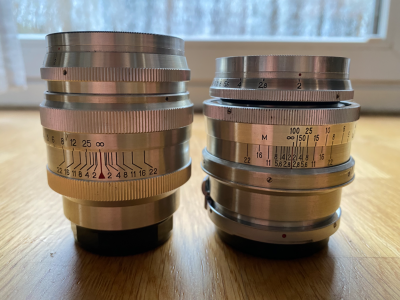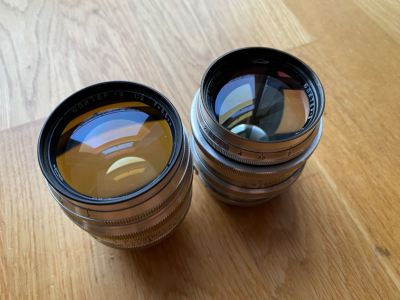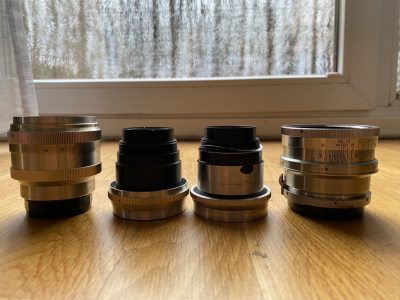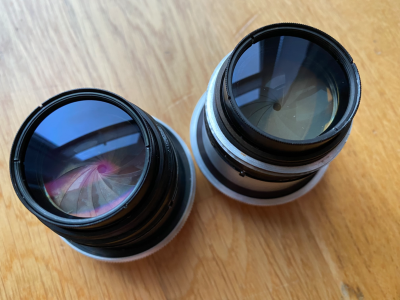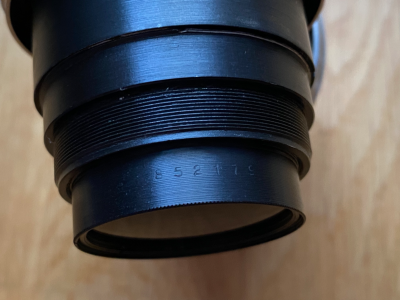You are using an out of date browser. It may not display this or other websites correctly.
You should upgrade or use an alternative browser.
You should upgrade or use an alternative browser.
Early Russian Lenses, What Features to look for.
- Thread starter Sonnar Brian
- Start date
- Latest activity Latest activity:
- Replies 237
- Views 18K
MM24
Newbie
I have two KMZ Jupiter 9 lenses from 1951. One is l39 and other kiev mount. The l39 one has a number on a rear block, but that number seems a bit poorly imprinted compared to how they usually are. So this probably is a fake number. Both of these two lenses have purple, yellow coatings, similar to my 1955 J9. Genuine czj and very early J-9 lenses(with czj optics) from that era have pale blue-ish coatings. Apeture blades are also different. L39 one has brown-ish and shiny baldes (I have a 1952 J11 ja a 1952 J3 with the same kind of shiny apeture blades) and kiev one have the usual matt blades as do the later KMZ J9-s. One little difference also cought my eye - l39 J9 has a matt name ring with a "N" before the number and the kiev J9 has shiny name ring with "№" before the number. Most of the very early J9-s I-ve seen on the web have just "N" before the number. What do you guys think, could there be a german made glass in those lenses or are the optics mostly/totally soviet made ?
Attachments
dexdog
Veteran
I think that these lenses are tough to figure out, fewer examples available and I am not aware of a lot of research into these lenses as done by Sonnar Brian, Rauber and others for the 5cm Sonnars and Jupiters. I have a three LTM J-9s and two CZJ- marked 8.5cm f2 lenses in LTM, but really do not have any idea as to how legitimate they are. The British writer P.G. Woodhouse would refer to them as "of uncertain parentage."I have two KMZ Jupiter 9 lenses from 1951. One is l39 and other kiev mount. The l39 one has a number on a rear block, but that number seems a bit poorly imprinted compared to how they usually are. So this probably is a fake number. Both of these two lenses have purple, yellow coatings, similar to my 1955 J9. Genuine czj and very early J-9 lenses(with czj optics) from that era have pale blue-ish coatings. Apeture blades are also different. L39 one has brown-ish and shiny baldes (I have a 1952 J11 ja a 1952 J3 with the same kind of shiny apeture blades) and kiev one have the usual matt blades as do the later KMZ J9-s. One little difference also cought my eye - l39 J9 has a matt name ring with a "N" before the number and the kiev J9 has shiny name ring with "№" before the number. Most of the very early J9-s I-ve seen on the web have just "N" before the number. What do you guys think, could there be a german made glass in those lenses or are the optics mostly/totally soviet made ?
Trio of J-9s, 1951, 1952 and 1953. The 1951 and 1952 have "N" serials, while the 1953 has "N degree" serial

The 1951 and 1952 lenses have the twin screws on the focus ring similar to early 5cm lenses, while the 1953 does not.

Last edited:
dexdog
Veteran
All of the above J-9s have yellowish coatings. The two CZJ-marked 8.5cm/2 lenses are different, one has the pale bluish-purple coating, the other is yellowish. The optical fixture of the 1951 and 1953 J-9s weigh 198g and 197g, respectively, while the 1952 weighs 236g. All three were weighed without the UV filters. I think that the optical fixture of 1952 lens has more brass than the other two. Also, the threading on the 1953 lens as shown on the right in the following pic is different than in the 1951 and 1952 lenses. The threading of the 1951 and 1952 lenses is similar, while the 1953 lens has different threading

The serial number stamp on the rear triplet of the 1951 lens is very clear and looks similar to other WW2 era CZJ lenses that I have. The serial number on the rear triplet of the 1952 lens is barely there, while the 1953 lens has no CZJ numbers on the triplet. The CZJ serial numbers correspond to Thiele's book with a production date of June 1946. Close-up of 1952 rear triplet, which is stamped 852313


The serial number stamp on the rear triplet of the 1951 lens is very clear and looks similar to other WW2 era CZJ lenses that I have. The serial number on the rear triplet of the 1952 lens is barely there, while the 1953 lens has no CZJ numbers on the triplet. The CZJ serial numbers correspond to Thiele's book with a production date of June 1946. Close-up of 1952 rear triplet, which is stamped 852313

Last edited:
dexdog
Veteran
Kinda off-topic, but neither of the two CZJ-marked 8.5cm/2 lenses have serial numbers stamped on the rear triplet, although there are a couple of typical CZJ parts numbers on the internals. The construction of the two CZJ-marked lenses are different, one is built like a WW2-era lens, while the other resembles the construction of the weird 5.8cm "Sonnars". I am guessing that both are what Sonnar B would refer to as "irregular production."
Last edited:
boojum
Ignoble Miscreant
I have a single 35mm KMZ Jupiter-12. Another eBay score that I got lucky on. One of our resident lens gurus, Sonnar Brian, has identified this as a Zeiss component KMZ Jupiter-12. It is a pretty good lens.
dexdog
Veteran
I would not call the name ring on my three J-9s matte. I had to turn the lenses around to avoid glare in the early afternoon sunlight. Probably just an issue of of semantics, I would call the finish of name rings on my lenses semi-gloss rather than matte, kinda shiny but not high gloss. I will look at color of iris blades tomorrowOne little difference also cought my eye - l39 J9 has a matt name ring with a "N" before the number and the kiev J9 has shiny name ring with "№" before the number.
Last edited:
Räuber
Well-known
@MM24 Could you please share a better picture of the name ring of the J9 with the engraved CZJ serial? It is almost nothing to see there.
@dexdog Thank you for sharing your lenses.
The 8,5cm f2 Sonnar and Jupiters are difficult to assess because there are not a lot of copies out there. When we look at the production batches the produced numbers were pretty low till the end of WWII and it seems it took very long to manufacture even 100 of them. So it is not unusual that only few are floating around the used market and in forums like this one. I have seen a pretty high amount of variations during wartime and especially at the end of the war.
It is basically the same story as with the 5cm Sonnar. When the Soviets ordered the relocation of the lens production to Krasnogorsk hitting in Spring 1946 they basically grept everything put it in boxes and transfered it to the FSU. You can imagine a pretty chaotic and on the same time controlled scene. There might have been some desperate Zeiss employees trying to hide parts, tools and unfinished lenses to later use this on the German black market. But most of the stuff ended up in Krasnogorsk. In Krasnogorsk Zeiss employees and KMZ employees started a training program to get a Sonnar production up and running. They started very likely easy with almost finished lenses where they only needed to assemble and finish engraving. Often times those 8,5cm Sonnars got a new LTM mount instead of a CRF mount to put it on a Soviet made Zorkii camera. There might be only some hundreds of those lenses. Most of them will have the typical CZJ name ring with a CZJ serial. At that time the employees might have been used up this stack of almost completed lenses pretty fast. After that phase they were left with a pile of parts and glass lenses from Zeiss and a lot of Schott glass. So they needed to manufacture the missing glass lenses (and add coating) and body parts inside KMZ. Those lenses got a new name ring with Jupiter name on it. Those lenses could be called Franken-lenses because they consist of Jena and KMZ parts. It is hard to to determine what part is from what origin. You would need microscopes or even analyse the material to be sure.
And then there are the German Franken-lenses. As mentioned before there might have been some people that have hidden or stolen Sonnar lens blocks and finished them later for the German black market. A lot of them got a LTM mount because US GIs asked for Leica lenses not Contax lenses. So it was easier to sell a LTM Sonnar to a US GI with a Leica around his neck. A lot of times those Sonnars are easy to spot by the engravings. They use different numbers than the CZJ or KMZ lenses. Sometimes the serial numbers are totally off.
And last but not least there was some kind of remounting service for German black market users. Some of the pre-war CRF 8,5cm Sonnar got a new mount post-war to sell it to Leica users. Sometimes someone owned a CRF Sonnar and a Leica so he went into one of those black market workshops where skilled (ex-Zeiss) craftsman added a Leica mount to it for money.
That might explain why it is so difficult to tell you the story of your particular Jupiter or Sonnar lens.
@dexdog Thank you for sharing your lenses.
The 8,5cm f2 Sonnar and Jupiters are difficult to assess because there are not a lot of copies out there. When we look at the production batches the produced numbers were pretty low till the end of WWII and it seems it took very long to manufacture even 100 of them. So it is not unusual that only few are floating around the used market and in forums like this one. I have seen a pretty high amount of variations during wartime and especially at the end of the war.
It is basically the same story as with the 5cm Sonnar. When the Soviets ordered the relocation of the lens production to Krasnogorsk hitting in Spring 1946 they basically grept everything put it in boxes and transfered it to the FSU. You can imagine a pretty chaotic and on the same time controlled scene. There might have been some desperate Zeiss employees trying to hide parts, tools and unfinished lenses to later use this on the German black market. But most of the stuff ended up in Krasnogorsk. In Krasnogorsk Zeiss employees and KMZ employees started a training program to get a Sonnar production up and running. They started very likely easy with almost finished lenses where they only needed to assemble and finish engraving. Often times those 8,5cm Sonnars got a new LTM mount instead of a CRF mount to put it on a Soviet made Zorkii camera. There might be only some hundreds of those lenses. Most of them will have the typical CZJ name ring with a CZJ serial. At that time the employees might have been used up this stack of almost completed lenses pretty fast. After that phase they were left with a pile of parts and glass lenses from Zeiss and a lot of Schott glass. So they needed to manufacture the missing glass lenses (and add coating) and body parts inside KMZ. Those lenses got a new name ring with Jupiter name on it. Those lenses could be called Franken-lenses because they consist of Jena and KMZ parts. It is hard to to determine what part is from what origin. You would need microscopes or even analyse the material to be sure.
And then there are the German Franken-lenses. As mentioned before there might have been some people that have hidden or stolen Sonnar lens blocks and finished them later for the German black market. A lot of them got a LTM mount because US GIs asked for Leica lenses not Contax lenses. So it was easier to sell a LTM Sonnar to a US GI with a Leica around his neck. A lot of times those Sonnars are easy to spot by the engravings. They use different numbers than the CZJ or KMZ lenses. Sometimes the serial numbers are totally off.
And last but not least there was some kind of remounting service for German black market users. Some of the pre-war CRF 8,5cm Sonnar got a new mount post-war to sell it to Leica users. Sometimes someone owned a CRF Sonnar and a Leica so he went into one of those black market workshops where skilled (ex-Zeiss) craftsman added a Leica mount to it for money.
That might explain why it is so difficult to tell you the story of your particular Jupiter or Sonnar lens.
Last edited:
dexdog
Veteran
Räuber
Well-known
I have to confess that the engravings of the Sonnar 8,5cm (and probably 13,5cm) are a real challenge for me. The issue with it is that CZJ used different font faces on different scales. And I'm not good in seeing the differences. I haven't found my way into it yet.
Yes the engravings differ from each other but I think they were engraved by KMZ. Especially the right DOF scale shows an "error" at the number 4 that I have only seen on post-war Sonnars that I would point to KMZ's earlier Sonnar lenses. Interesting is the infinity mark too that differs a lot. I tried to look through samples of pre-war and post-war Sonnar 8,5cm. The left mark looks like post-war CZJ infinity signs looks a little bit like post-war CZJ. But I think this is a false trail. It will lead to nothing. In the end I would say both aperture scales were engraved by Soviets.
The proof lies in the first value of the aperture scale. Both Jupiter-9s show a 25 meter mark. CZJ never engraved a Sonnar 8,5cm with a 25 mark.
Black Nickel = 20

pre-war Chrome = 20

pre-war later chrome = 100 with zig-zag

pre-war chrome with meter and feet scale = 300

I haven't seen a single LTM Sonnar 8,5cm that I would consider authentic CZJ yet. The closest one would be this one.

Or this one. Look for the 4 on both lenses.


post-war CZJ = 30 and with feet scale


post-war Opton = 300 feet or 100 m


Yes the engravings differ from each other but I think they were engraved by KMZ. Especially the right DOF scale shows an "error" at the number 4 that I have only seen on post-war Sonnars that I would point to KMZ's earlier Sonnar lenses. Interesting is the infinity mark too that differs a lot. I tried to look through samples of pre-war and post-war Sonnar 8,5cm. The left mark looks like post-war CZJ infinity signs looks a little bit like post-war CZJ. But I think this is a false trail. It will lead to nothing. In the end I would say both aperture scales were engraved by Soviets.
The proof lies in the first value of the aperture scale. Both Jupiter-9s show a 25 meter mark. CZJ never engraved a Sonnar 8,5cm with a 25 mark.
Black Nickel = 20

pre-war Chrome = 20

pre-war later chrome = 100 with zig-zag

pre-war chrome with meter and feet scale = 300

I haven't seen a single LTM Sonnar 8,5cm that I would consider authentic CZJ yet. The closest one would be this one.

Or this one. Look for the 4 on both lenses.


post-war CZJ = 30 and with feet scale


post-war Opton = 300 feet or 100 m


dexdog
Veteran
Räuber
Well-known
@dexdog Can you please share more photos of both lenses? Name ring, aperture ring and focus scale. I have seen so much variations in the wartime production that I can not confirm anything by looking at one image of a Sonnar 8,5cm. Would be great to see some authentic CZJ LTM Sonnar 8,5cm. I was not sure if some exists.
dexdog
Veteran
Last edited:
dexdog
Veteran
dexdog
Veteran
dexdog
Veteran
Räuber
Well-known
@dexdog I finally had the chance to look at the pictures of the two 8,5cm Sonnar lenses. Unfortunately I have to tell you that in my opinion they were not manufactured completely by CZJ. Although the aperture scale, the focus scale and DOF scale show the typical CZJ numbers engraved the name ring is the issue here. Look at the serials and especially at the number 4 and 7. Compare those both numbers to other Contax lenses from CZJ and you will see the difference. The engravings of the serial number did not change post-war. The engraved serial on the name ring is not done by the Soviets. If you compare the serial with your Jupiter-9 lenses you will notice the difference too. No, this serial is engraved by a German engineer but not a CZJ one. I point to the German black market. But if you compare it with an Opton Sonnar you will see the stark similarities. Draw your conclusions.
dexdog
Veteran
Rauber, I was already of the opinion that these lenses were irregular production or black market products. I welcome your thoughts on these two lenses! They are not badly made lenses, just not as smooth or nicely put together as real CZJ, Zeiss-Opton or Carl Zeiss products.@dexdog I finally had the chance to look at the pictures of the two 8,5cm Sonnar lenses. Unfortunately I have to tell you that in my opinion they were not manufactured completely by CZJ. Although the aperture scale, the focus scale and DOF scale show the typical CZJ numbers engraved the name ring is the issue here. Look at the serials and especially at the number 4 and 7. Compare those both numbers to other Contax lenses from CZJ and you will see the difference. The engravings of the serial number did not change post-war. The engraved serial on the name ring is not done by the Soviets. If you compare the serial with your Jupiter-9 lenses you will notice the difference too. No, this serial is engraved by a German engineer but not a CZJ one. I point to the German black market. But if you compare it with an Opton Sonnar you will see the stark similarities. Draw your conclusions.
Last edited:
Similar threads
- Replies
- 6
- Views
- 590
- Replies
- 8
- Views
- 730
- Replies
- 3
- Views
- 165
- Replies
- 16
- Views
- 2K



